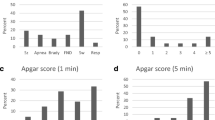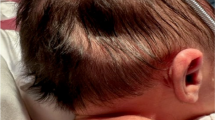Abstract
A case of growing skull fracture following birth trauma and caused by vacuum extraction is reported in order to emphasize the incidence of this peculiar head injury at the beginning of extrauterine life and to point out its relation to possible neuropsychological disturbances that may appear later in childhood. Delivery by vacuum extraction increases the incidence of perinatal injuries and consequently the incidence of neurological deficits in children. Neurosurgical repair is advocated as the appropriate treatment, with the aim not only of cosmetically correcting the lesion's typical subgaleal protuberance with cranioplasty, but also of performing a water-tight closure of the dura, enabling the cerebral cortex to “fill in” the intracerebral lesion. The surgical technique and gross pathology of the lesion are described together with radiological findings before and after surgery. Reports by other authors are reviewed in an attempt to identify the conditioning factors and pathological features of this traumatic injury to skull and brain in neonates and infants. The literature on cranial fractures associated with intracerebral lesions at this age shows a significant difference in recovery and outcome from that after similar lesions in older children.
Similar content being viewed by others
References
Arseni C, Ciurea AV (1981) Clinicotherapeutic aspects of growing skull fractures. Child's Brain 8:161–172
Avrahami E, Frishman E, Minz M (1993) CT demonstration of intracranial hemorrhage in term newborn following vacuum extractor delivery. Neuroradiology 35:107–108
Barkovich AJ (1990) Contemporary neuroimaging, vol I. Raven Press, New York, pp 64–65
Benaron DA (1993) Subgaleal hematoma causing hypovolemic shock during delivery after failed vacuum extraction: a case report. J Perinatol 13: 228–231
Chiofalo N, Madsen J, Basauri L (1986) Perinatal and posttraumatic seizures. In: Raimondi AJ, Choux M, Di Rocco C (eds) Head injuries in the newborn and infant. Springer, New York Berlin Heidelberg, pp 217–232
Choux M (1986) Incidence, diagnosis and management of skull fractures. In: Raimondi AJ, Choux M, Di Rocco C (eds) Head injuries in the newborn and infant. Springer, New York Berlin Heidelberg, pp 163–182
Di Rocco C, Velardi F (1986) Epidemiology and etiology of craniocerebral trauma in the first two years of life. In: Raimondi AJ, Choux M, Di Rocco C (eds) Head injuries in the newborn and infant. Springer, New York Berlin Heidelberg, pp 125–139
Eben A, Courtland HD (1969) Intrauterine fracture of the infant's skull. J Neurosurg 30:446–454
Hoppe-Hirsch E, Hirsch JF (1993) Severe injury in children. Crit Rev Neurosurg 3:260–266
Hovind KH (1986) Traumatic birth injuries. In: Raimondi AJ, Choux M, Di Rocco C (eds) Head injuries in the newborn and infant. Springer, New York Berlin Heidelberg, pp 87–109
Kingsley D, Till K, Hoare R (1978) Growing fractures of the skull. J Neurol Neurosurg Psychiatry 41:312–318
Lende RA, Erickson TC (1961) Growing skull fractures of childhood. J Neurosurg 18:479–489
Raimondi AJ, Hirschauer J (1986) Clinical criteria-Children's Coma Score and Outcome Scale-for decision making in managing head-injured children and toddlers. In: Raimondi AJ, Choux M, Di Rocco C (eds) Head injuries in the newborn and infant. Springer, New York Berlin Heidelberg, pp 141–150
Ramamurthi B, Kalyanaraman S (1970) Rationale for surgery in growing fractures of the skull. J Neurosurg 32:427–430
Rifkinson-Mann S (1993) Head injuries in infants and young children. Contemp Neurosurg 15:1–6
Scarf TB, Fine M (1985) Growing skull fractures of childhood. In: Wilkins RH, Rengachary SS (eds) Neurosurgery. McGraw-Hill, New York, pp 1627–1628
Scarfo GB, Mariottini A, Tomaccini D, Palma L (1989) Growing skull fractures: progressive evolution of brain damage and effectiveness of surgical treatment. Child's Nerv Syst 5:93–98
Tandon PN, Banerji AK, Bhatia R, Goulatia RK (1987) Cranio-cerebral erosion (growing skull fracture of children). II. Clinical and radiological observations. Acta Neurochir (Wien) 88: 1–9
Taveras JM, Ransohoff J (1953) Leptomeningeal cysts of the brain following trauma with erosion of the skull: a study of seven cases treated by surgery. J Neurosurg 10:233–241
Author information
Authors and Affiliations
Rights and permissions
About this article
Cite this article
Papaefthymiou, G., Oberbauer, R. & Pendl, G. Craniocerebral birth trauma caused by vacuum extraction: a case of growing skull fracture as a perinatal complication. Child's Nerv Syst 12, 117–120 (1996). https://doi.org/10.1007/BF00819511
Received:
Issue Date:
DOI: https://doi.org/10.1007/BF00819511




